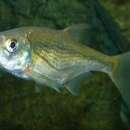en
names in breadcrumbs


Alburnoides bipunctatus, known vernacularly as the schneider, spirlin,[1] bleak, riffle minnow, and others,[2] is a species of small (9-cm average length) freshwater fish in the family Cyprinidae. It is found in Afghanistan, Armenia, Austria, Azerbaijan, Belarus, Belgium, Bulgaria, Czech Republic, Croatia, Estonia, France, Georgia, Germany, Hungary, Iran, Latvia, Lithuania, Moldova, the Netherlands, North Macedonia, Poland, Romania, Russia, Serbia, Slovakia, Slovenia, Switzerland, Turkey, Ukraine, and Uzbekistan. This fish inhabits rivers with very calm waters, and it eats dead insects and insect larvae, diatoms, and crustaceans. It reproduces during April to June.[3]
Alburnoides bipunctatus, known vernacularly as the schneider, spirlin, bleak, riffle minnow, and others, is a species of small (9-cm average length) freshwater fish in the family Cyprinidae. It is found in Afghanistan, Armenia, Austria, Azerbaijan, Belarus, Belgium, Bulgaria, Czech Republic, Croatia, Estonia, France, Georgia, Germany, Hungary, Iran, Latvia, Lithuania, Moldova, the Netherlands, North Macedonia, Poland, Romania, Russia, Serbia, Slovakia, Slovenia, Switzerland, Turkey, Ukraine, and Uzbekistan. This fish inhabits rivers with very calm waters, and it eats dead insects and insect larvae, diatoms, and crustaceans. It reproduces during April to June.